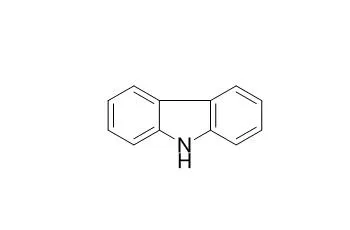| In vitro: |
| Bioorg Med Chem Lett. 2010 Mar 15;20(6):1881-4. | | Synthesis, antibacterial and antifungal activities of some carbazole derivatives.[Pubmed: 20176480 ] |
METHODS AND RESULTS:
A series of N-substituted Carbazole derivatives were synthesized and evaluated for antibacterial and antifungal activities against Staphylococcus aureus, methicillin-resistant Staphylococcus aureus (MRSA), Bacillus subtilis, Escherichia coli, Pseudomonas aeruginosa, Bacillus proteus, Candida albicans and Aspergillus fumigatus by two fold serial dilution technique.
CONCLUSIONS:
Some of the synthesized compounds displayed comparable or even better antibacterial and antifungal activities than reference drugs fluconazole, chloramphenicol and norfloxacin against tested strains. | | Soil Science Society of America Journal, 1989, 53(5):1391-1401. | | Carbazole Sorption by Surface and Subsurface Materials: Influence of Sorbent and Solvent Properties[Reference: WebLink] |
METHODS AND RESULTS:
Sorption of 9H-Carbazole was investigated from aqueous and cosolvent solutions on soils with different physical and chemical properties. Sorption was nonlinear, but well correlated to the organic carbon (OC) content of the soils.
CONCLUSIONS:
For a given solvent (i.e., MeOH, acetone) the log-linear behavior is independent of sorbent properties and exhibits a common slope, thus attesting to the importance of the solvent interaction. In contrast, pyridine as a cosolvent is actively sorbed by some soils creating a more oleophilic surface and a tendency to increase Carbazole partitioning to the soil surface. |
|






 Cell. 2018 Jan 11;172(1-2):249-261.e12. doi: 10.1016/j.cell.2017.12.019.IF=36.216(2019)
Cell. 2018 Jan 11;172(1-2):249-261.e12. doi: 10.1016/j.cell.2017.12.019.IF=36.216(2019) Cell Metab. 2020 Mar 3;31(3):534-548.e5. doi: 10.1016/j.cmet.2020.01.002.IF=22.415(2019)
Cell Metab. 2020 Mar 3;31(3):534-548.e5. doi: 10.1016/j.cmet.2020.01.002.IF=22.415(2019) Mol Cell. 2017 Nov 16;68(4):673-685.e6. doi: 10.1016/j.molcel.2017.10.022.IF=14.548(2019)
Mol Cell. 2017 Nov 16;68(4):673-685.e6. doi: 10.1016/j.molcel.2017.10.022.IF=14.548(2019)